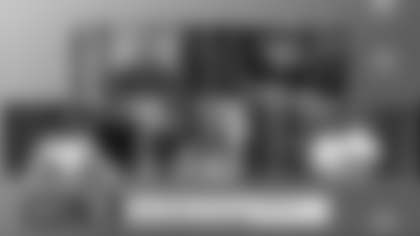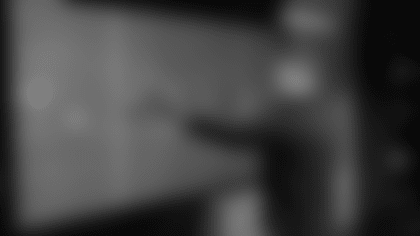Welp, the Vikings are looking at a big climb out of an 0-3 start.
Minnesota fell 28-24 to the Los Angeles Chargers on Sunday, dropping to 0-2 in home games after a couple of wacky bounces, a day on offense that moved the ball well except when it was time to cross the goal line and a day on defense that led to historic performances by Chargers QB Justin Herbert and WR Keenan Allen.
The Vikings will try to break their slump against the 0-3 Panthers next Sunday in Charlotte, but first here's a deeper dive on what loomed large in the loss to the Chargers.
Next Gen Stats
Completions over expectations
Vikings.com's Ellis Williams noted the high blitz rate the Vikings tried on Sunday against Herbert, but he was able to get the football out faster than he ever has before, and it usually resulted in a completion.
According to Next Gen Stats, Herbert's average time to throw was 2.26 seconds, marking the first time of his career (52 regular-season games) that he averaged a time less than 2.40 seconds. He also became the first player in the Next Gen Stats era to throw for more than 300 yards in a game against the blitz. NGS calculated his numbers at 32-of-38 passing for 307 yards and three touchdowns against Minnesota's blitzes.
NGS also noted his career-high completion percentage of 85.1 (40-for-47) was helped by a completion rate that was a career-best 14.5 percent over expected, the highest rate by a QB with at least 45 pass attempts in a game.
A couple of plays really standout with regard to having a completion rate above the 70.6 (still really high) that NGS calculated as what should have been.
The first was the 35-yard completion that Mike Williams vacuumed up just before it hit the turf to beat solid coverage by Byron Murphy, Jr.
The second was the 30-yard touchdown pass to Joshua Palmer that proved to be the game's decisive score. Akayleb Evans leaped backward to corral the underthrown ball. It hit his hands before bouncing off his helmet, off Palmer's right wrist, right hand, left hand and left thigh before the right hand returned to pin the ball against his stomach.
The Warren Commission would struggle to explain that one.
Allen on autopilot
Herbert's favorite target of the day was Allen, who recorded 18 catches for 215 yards on 20 targets.
According to Next Gen Stats, Allen was classified as "open" (more than 3 yards of separation from the nearest defender) 13 times. He caught each of those passes, resulting in 140 of his yards on the day.
Minnesota's blitzing was leaving some openings in the secondary that Herbert and Allen were finding.
Of his 215 receiving yards, 104 were tallied after catches.
Cousins under duress
Kirk Cousins was sacked four times, hit 13 times and pressured on multiple other instances.
According to NGS, Tuli Tuipulotu was credited with 10 quarterback pressures, the second-most by a rookie in a single game in the NGS era.
Veterans Khalil Mack (six), Sebastian Joseph-Day (four), Joey Bosa (three) and Morgan Fox (three) also got in on the action.
Bosa turned in one of the more impactful pressures and hits when he knocked the arm of Cousins as the quarterback was trying to release the football to a wide-open Alexander Mattison on third-and-goal from the 5 late in the second quarter. Mattison would have been waltzing into the end zone if the ball was able to reach him.
Snap Counts
Cousins and all five offensive linemen who started — LT Christian Darrisaw, LG Ezra Cleveland, C Austin Schlottmann, RG Ed Ingram, RT Brian O'Neill — played all 82 offensive snaps.
Jefferson was in the game for 78 snaps, despite dealing with cramps late. K.J. Osborn played 76 snaps, and T.J. Hockenson was in the game for 73. Rookie Jordan Addison played a career-high 58.
Mattison totaled 58 snaps on offense, compared to 12 at running back by Ty Chandler.
On defense, Camryn Bynum and Jordan Hicks played all 66 snaps. Josh Metellus and Harrison Smith each played 63 defensive snaps. Byron Murphy, Jr., left the game briefly with a contusion but returned and played 62 defensive snaps. Evans played 60 snaps on defense.
Outside linebackers Danielle Hunter (61) and D.J. Wonnum (59) led their position group. Andre Carter II played 14 defensive snaps and 10 special teams snaps in his NFL debut.
Also active for the first time, rookie defensive lineman Jaquelin Roy was on the field for nine defensive snaps and six special teams snaps.
From the Inbox
Tons of emails in the inbox, so I'm going to try to get to as many as I can and will be a bit briefer in responses than with the Mailbag.
I know you need to move on, but letting Dalvin Cook go makes a difference. Defenses need someone to fear in the back field. It opens up the whole offense because at some point he will make a big play.
— Kelvin Harding
The ground game was able to get a few double-digit gains against the Chargers, who often utilized two safeties deep. I think the Vikings were going to keep running the ball on that opening drive if not for the Hockenson fumble.
It's hard to quantify what Cook's ability to break off big runs resulted in with how teams approached the Vikings, but it is certain that teams needed to respect it. The Vikings still have more work to do to establish their ground game going forward.
Why doesn't Kirk Cousins take off and run more to open up the offense?
— Michael Karsnitz
There were probably a couple of times when Cousins could have tucked the football and run with it for a few yards, but openings tend to close fast in the NFL.
I think philosophically with the passing game and route concepts, he might be trying to give them time to develop for the best chance of success on a play.
Three games in a row, the Vikings have found a way to self-destruct. Do you think the starters not playing during training camp preseason games has affected their performance?
— Larry Vickery in Sioux Falls, South Dakota
There's certainly been moments when the team hasn't looked as sharp as it did a year ago, but the starters didn't play much or at all in the 2022 preseason, and mistakes in that regular season weren't as prevalent as they've been this year.
It seems like everyone has taken a turn at making a mistake — a turnover, missed block, missed tackle or other mental error. Shared blame equals a shared responsibility for cleaning up the miscues.
I thought I heard something about O'Connell was going to revisit the idea of assessing the offensive line come this week. Why hasn't he done this sooner? Why do they keep rolling out the same offensive line group every week knowing they are not getting the job done? Why not plug in other guys instead? It's mind blowing and boggling and confusing as to what's going on!
— Joshua Kiel in Owatonna (Lifelong fan since 1987)
For the first time of 2023, the Vikings were able to get through an entire game with the players who started on the offensive line, but the amount of duress that Cousins was under, and the inability to punch the ball in at the goal line were visible problems.
Minnesota just brought in Dalton Risner last week, and I'm sure coaches will continue to evaluate how to get the best five together on the field.
At what point in time do you think we should have been paying more attention to Keenan Allen? 18 catches and over 200 yds.
— William Bjerke
The blitz approach — and resulting openness of Allen — were addressed in the Next Gen Stats section above, but I guess the Vikings thought they'd finally get home on some of those blitzes. Too often, however, there were just pitches and catches between Herbert and Allen.
Herbert was in a good rhythm, even if he was playing faster than he normally does.
Greetings from Italy.
I believe that in Cousins' years, we always had same problems that never got resolved.
- very poor O-line: poor QB protection, very poor running play blocks
- poor D-line: contenders' QBs are never pressured enough and have time to make plays (especially crucial ones)
- very poor winning QB: Kirk is good for stats, when it comes the time to make a crucial play, he is a below-the-average QB. In other words, he is not a momentum/winning QB. You can ask him to not lose a game but it's very uncommon that he will make you win a game when it matters most.
We can speak about engagement, training, professional management, hard work, all topics for sure covered by our team, but until they don't fix the above problems, we will always remain a "never winning" team. And please let's not take last year as an example, our winning record is the most fake record that an NFL team has scored ever.
Skol!
— Davide from Italy
Starting with defense first. It's clear with so much blitzing that the Vikings didn't believe they had enough weapons to negatively affect Herbert by using the front alone.
I think the production by Cousins so far is a level at which most other NFL teams' fan bases would sign up for, but there were definitely a couple of throws that he'd like to have back. Leading Osborn another step on the crossing route in the end zone would have been a touchdown in the second quarter instead of a field goal. It sounded like Cousins also lamented the deep one to Osborn that fell incomplete after the stop by the Vikings defensive line.
I do politely disagree with discounting last year's results as "fake." There are numerous times when winning plays were made by Cousins and other players. As we've seen as recently as Sunday with Dallas falling at Arizona as a major favorite, the "any given Sunday" mantra can be true. Winning 13 games last season is not insignificant.
Get 53 balls. Every single player holds the ball till we get a game with 0 turnovers, and we turn the script around!!!
SKOL,
— Toby in Alaska
I've kind of envisioned real or fictitious exercises to promote ball security. It was emphasized last week, and I'm sure the drumbeat will continue. O'Connell doesn't seem to be a gimmicky coach or at least didn't need to implement those tactics last season. If things don't improve, I'd suspect he'll come up with a few more ways to emphasize protecting the football.
In your opinion should KOC give up the offensive play calling duties to concentrate on the overall game situation? I have never thought it a good idea. Ditto with Mike Zimmer and the defense!
— Brent Lunke
Appreciate the question here, and you aren't the first emailer to inquire about this. But that's well beyond me. I personally believe O'Connell has had a good showing of calling plays, but when 25 percent of a team's possessions have ended with a turnover, that's more of an execution component than who called in the play.
Minnesota has coaches who help with game management. Even so, there's always going to be a few plays a game that any play caller will want back. Minnesota's margin for error was small last season and has continued to shrink with all the turnovers.
So many people are dogging on Kirk Cousins. He's not the problem! It's a mixture of his offensive line (no protection) and our once-was-good defensive line. Too many mistakes!
— Joanne Dannenberg
I don't ever see coaches' grades for players, but O'Connell did mention that even players who scored 100 in the evaluation need to try to find one more thing to do better or one more way to help the team. Again, the production by Cousins is the biggest surprise in contrast to an 0-3 start.
This result should not be a surprise given the dismantling of the team in the offseason by the GM! He needs to be replaced!
— Steve Holder
There's certain contracts that were no longer tenable for the salary cap, but the Vikings did lose a lot of leadership and players who had been part of plenty of disappointing losses and thrilling wins over their careers. I don't think there's a shortage of leadership, but the team has not closed games the way it did last season.
Coach,
Do you not know that the QB can be assisted across the line for a TD??
We had first-and-goal on the 3-yard line.
Run a QB Sneak, run it three times if needed.
You should have learned this from Philly. They did it to us with no problem — just a TD.
Some of the worst play calling I've seen.
— Howie Dawson
and
First time writer.
Why on the first attempt to take the lead when score was 28-24 and we ran the ball to the 1-foot line did we not QB sneak the ball? We are down 4, we are not going to take a FG, and we have three downs to get 1 foot. This is a copycat league, and if something works, everyone uses it and guess what, the QB sneak with two or three guys pushing works. We definitely would not have lost yards and had to go a pass play.
Then when we get a first down after a fourth-down play with 20+ seconds left, isn't it automatic that you spike the ball? I understand the thought process of keep the defense on their heels and keep the momentum, but to me it just seems spike the ball get organized and now you definitely have time for three plays to get it in the end zone and you might even be able to run one of them.
— Mike in Apopka, Florida
Combining the thoughts from Howie and Mike here. The Eagles are the gold standard for the QB sneak. Jalen Hurts squated 600 pounds in college, and their mauling offensive line is exceptional with its collective technique and winning leverage on those plays.
The Vikings offensive line hasn't been able to redefine the line of scrimmage much, but it does seem like having the ball that close invites the thought of a QB sneak.
Mike's point to stopping the clock and maybe having enough time to run is interesting, but I think it's too big of a risk to call a run play at that point without a timeout, just because defenders can really create delays in getting the ball reset.
But yes, the frantic finish, in hindsight, would have benefited much more from a spike to save time.
I believe that our offense is solid except for turnovers. 24 points should be enough if our defense was better. We were picked apart again!!!
I think it's either poor DC calls or bad players. Both maybe...
The Vikes are right there. Give up one less TD per game, and we're 3-0.
— Tony Tracy in Kettle River
There's some offenses and quarterbacks where a team would feel pretty good about putting up 24 points and walking away with a victory, but Herbert and the Chargers playmakers are good enough, where it's probably a better idea to try to exceed 24 points. Herbert had an excellent day, but the pass that should have been picked off would knock that score down from 28.
The Vikings definitely had incredible chances to put up 30 or more on the day.
As a loyal Viking fan, I only want to see the Vikings get better and win.
2 thoughts:
It seems like last year when the Vikings offense came out with some speed in their opening drive their play was more focused and intense. Cousins got rid of the ball early. We had a mix of run-pass. Man would I love to watch and analyze film.
Our o-line needs a lot of work to protect Cousins and to support the running game. Until that happens, we need our coaches to plan a different scheme.
Our losses are on the coaching side of each of these games.
Thanks for listening,
— Laurie
The 2022 days of marching down the field for an opening drive touchdown have gotten smaller in the rearview mirror. There were some beautiful symphonies of blending personnel to attack on opening drives. The early scores were quite helpful in winning games last season, but they have not shown up so far this year.
The plan to establish the run against the defense that the Chargers opened with was working until the fumble, but a drive that began at the Minnesota 43-yard line resulted in zero points after the Vikings drove 40 yards on seven plays.
Against the Buccaneers, the Vikings netted 3 yards on their first possession of 2023 (a three-and-out that included an 8-yard pass that was quickly followed by a 5-yard penalty). Minnesota went four-and-punt after gaining 16 yards at Philadelphia on its first possession of Week 2.






















